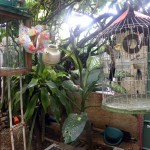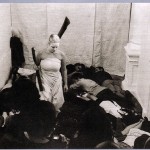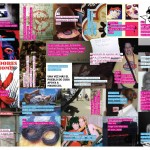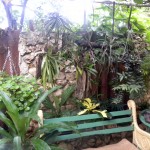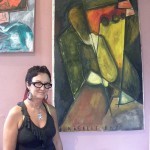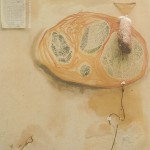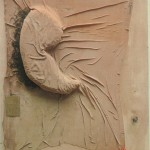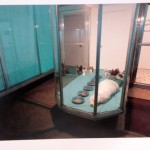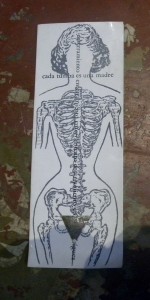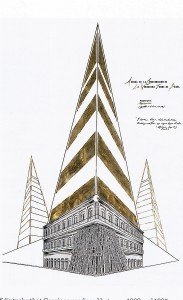Art in Cuba Now Part II Espacio Aglutinador
Espacio Aglutinador was founded in 1994 by Sandra Ceballos and Ezequiel Suárez. The title means a space that helps people and events come together ( a root word here is gluten) . It is the oldest ongoing independent art space in Cuba that is entirely independent of the government. Because it is a private home, events cannot be interfered with by the police.
The initial impulse for creating an art space was the censoring of an exhibition by Ezequiel Suárez called The Bauhaus Front in which the artist painted images on cardboard of various prominent people holding signs that declared for example “ The Museum of Fine Arts is shit.” It was an act of defiance against the official art venues in Havana. This Dada spirit of the Bauhaus inspired many multimedia events and exhibitions in Espacio.
The spirit of defiance and revolution against expected actions persisted inside this intimate space, even as outside the strange fluctuations of oppressions, contradictions, and successes abroad for Cuban artists continued.The social interaction is intense and powerful.
From the beginning, major critics Orlando Hernandez, Gerardo Mosquera, and Eugenio Valdes Figueroa, to name only three, have been writing catalogs and articles about the Espacio.
Espacio Aglutinador has created more than 90 events in collaboration with various artists and collectives. Many of these artists are now famous, and often the work they showed in this space was fundamental to their later fame or brought them out of eclipse.
The main principle is that it is a space that welcomes everyone, it is democratic, including young and old, trained and untrained, famous and undiscovered, living and dead. “It is a cultural space, nor a boutique, nor a foundation. It does not intend to be elitist or avangardist, populist or backward looking. … It is not a project, nor is it a beautiful idea on paper. ..Aglutinador is an event… The possibilities for error are infinite.” The artists that were shown there in the 1990s were chosen by Sandra Ceballos and Ezequiel Suárez. Some of them had been neglected, some had been censored, some were simply artists that they admired including US based Ana Mendieta and Coco Fusco.
One example is Angel Delgado who was actually put in prison because he did a performance piece in an exhibition called “The Sculptural Object” in which he defecated in one of the galleries on a copy of the Communist newspaper Granma. He was put in prison for six months: he took everything he had used while in prison in a wooden box, including 102 drawings and stories and sculptures of soap, drawings on hankerchiefs (techniques learned from other prisoners), and opened it for the first time for an exhibition at the Espacio Aglutinador in 1996. Orlando Hernandez wrote asking for his pardon: “ I see in your exhibition not only a harrowing testimony to your sadness, of your revulsion, . . . but also our own shamelessness, our weakness, and guilt.” The postscript to this work is discussed on this blog, in which the writer declares that Delgado has made a successful career from this work inpsired by prisoners media, without ever taking up there cause himself.
Another artist who had an installation there was Tania Bruguera. Her performance piece Cabeza Abajo in late 1996 included 20 participants who lay on the floor tied up. The artist as a ghost like figure walks over them, suggesting oppression, the experience of collective death, a ritual landscape full of sacrificed ideals.
By 2000, as the Cuban art scene was rapidly changing, Eugenio Valdes Figueroa wrote “ in the midst of the tensions provoked by censorship on the Island, Aglutinador offers a space for projects that have little possibility to satisfy the commercial trends stimulated by the demand for Cuban art from the outside. . . Amidst the proliferation of easily saleable formulas . . . and banal themes . . . “ it was an institution that spoke to forbidden themes and mined the uncertainties of local themes. (Espacio Aglutinador 1994 – 2004,un lugar de emergencia, p 62). Starting in 2003, a second phase of Espacio began that was even more revolutionary, without curators, without any restrictions.
One example was the exhibition “Curators Go Home” which included the piece on censorship by Celia/Yunior and friends described in my previous blog. That piece can still be seen in the Espacio Aglutinador drawn on the wall behind the work of other artists.
Sandra Ceballos, the ongoing director of Espacio Aglutinador, is a radical both in her life and in her art. She attended the Academia de San Alejandro in the early 1980s, a productive period of Cuban art, but she herself was defiant and feisty of art school norms and was expelled for behaving as an existentialist, not a worker.
But she went back and graduated, but chose not to attend the Istituto Superior de Arte (ISA). In the early 1990s she received a prestigious prize for her art and was given a one person show, but she chose once again to be defiant and showed radical feminist body art.
She has said that her ongoing radical activities and art have barred her from showing at any government sponsored spaces, and the one work by her in the National Museum is not on display.
She has worked in series, one series was focused on the fragility of human existence, the limits of our mortality in a hospital environment, another series is about the fanaticism of ideology using Fidel’s speeches as a point of departure which she wrote down frantically as though demented. Her discussion of her work and her space are on this excellent video interview. In one amusing comment she describes the space as a send up of the pomposity and seriousness of the Museum of Fine Arts in Havana. In her small house, the art is shown in the kitchen, in the garden, even in the bathroom, as well as the tiny living room.
Two other examples of radical artists who showed in Espacio Aglutinador are Colette Rodriguez and Carlos Garaicoa. Rodriguez’s work was described as hyperrealist and the catalog that accompanied her exhibition had a triangle of what people thought was pot attached to it.
Carlos Garaicoa created a series of conceptual diptychs of crumbling Havana buildings paired with austere pyramids, invoking the Tower of Babel in his title. Such an analogy was particularly apt for the strange contradictory environment of Havana, full of principles in the air, and disappointment on the ground.
Ceballos continues to sponsor radical art collaboration and events at Espacio Aglutinador. It is an incredibly important place for Cuban art as both a concept of absolute artistic freedom in the Dada tradition, and as a space that celebrates a spirit of collaboration and mutual support even as the forces of capitalism drive artists toward pursuit of individual monetary success and compromise.
The history of Cuban art and Cuba is frought with deep contradictions, strange slogans, rapid reversals from freedom to oppression, unpredictable promotions, and commodification of its own story, but the Cuban artists that I met continue to produce thoughtful work which successfully brings together art and critique with intelligence and subtlety.
This entry was posted on January 3, 2012 and is filed under Espacio Aglutinador Havana Cuba.

